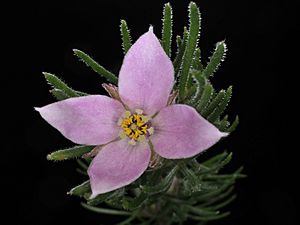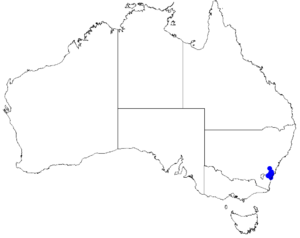Boronia subulifolia facts for kids
Quick facts for kids Boronia subulifolia |
|
|---|---|
 |
|
| Boronia subulifolia in the Australian National Botanic Gardens | |
| Scientific classification | |
 |
|
| Occurrence data from Australasian Virtual Herbarium |
Boronia subulifolia is a special kind of plant that belongs to the citrus family, called Rutaceae. You can only find this plant in a small part of south-eastern New South Wales in Australia. It's a tall, woody bush with leaves that look like feathers, having many narrow parts called leaflets. Its flowers are usually light to deep pink and have four petals. These pretty flowers grow where the leaves meet the stem or at the very ends of the branches.
Contents
Discovering Boronia subulifolia
Boronia subulifolia is a straight, woody shrub. It can grow to be about 0.25–1.2 m (0.8–4 ft) tall. Its younger stems might feel a bit hairy.
Leaves and Leaflets
The leaves of this plant are quite interesting. They are "pinnate," which means they look a bit like a feather. Each leaf usually has five or seven smaller parts called leaflets. The whole leaf, including its stalk (called a petiole), is about 6–20 mm (0.2–0.8 in) long and 4–26 mm (0.2–1 in) wide. The petiole itself is only about 1–4 mm (0.04–0.2 in) long.
The individual leaflets are narrow and pointed, like tiny spears. They are about 2.5–15 mm (0.1–0.6 in) long and only 0.5–1 mm (0.02–0.04 in) wide.
Flowers and Fruit
The flowers of Boronia subulifolia are a lovely light to deep pink color. They usually grow one by one where a leaf joins the stem (this spot is called a leaf axil) or at the very tips of the branches. Each flower sits on a tiny stalk called a pedicel, which is only about 1 mm (0.04 in) long.
Each flower has four small, narrow, triangular parts called sepals. These sepals are about 2.5–4 mm (0.1–0.2 in) long and 1–2 mm (0.04–0.08 in) wide. They are a bit hairy on their underside. The four petals are larger, about 5–8 mm (0.20–0.31 in) long, and also slightly hairy.
Inside the flower, the part that receives pollen is called the stigma. It's about the same width as the stalk that supports it, which is called the style.
This plant blooms from September to January. After the flowers, it produces a fruit called a capsule. This capsule is mostly smooth (not hairy) and is about 3–4.5 mm (0.12–0.18 in) long and 1.5–2.5 mm (0.06–0.1 in) wide.
Naming and Classification
The plant Boronia subulifolia was officially described for the first time in 1928. This description was made by a botanist named Edwin Cheel. He published his findings in a scientific journal called Journal and Proceedings of the Royal Society of New South Wales.
What Does the Name Mean?
The second part of the plant's scientific name, subulifolia, comes from two Latin words.
- subula means "an awl" (which is a pointed tool).
- folium means "a leaf".
So, the name subulifolia refers to the plant's finely pointed leaflets.
Where It Grows
You can find Boronia subulifolia growing in areas with heath and woodland. It prefers rocky sandstone soil. Most of these plants are found in the Budawang Range in New South Wales, Australia.

